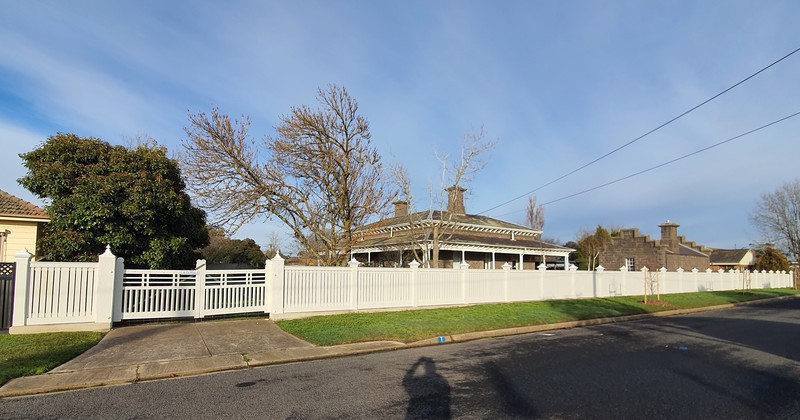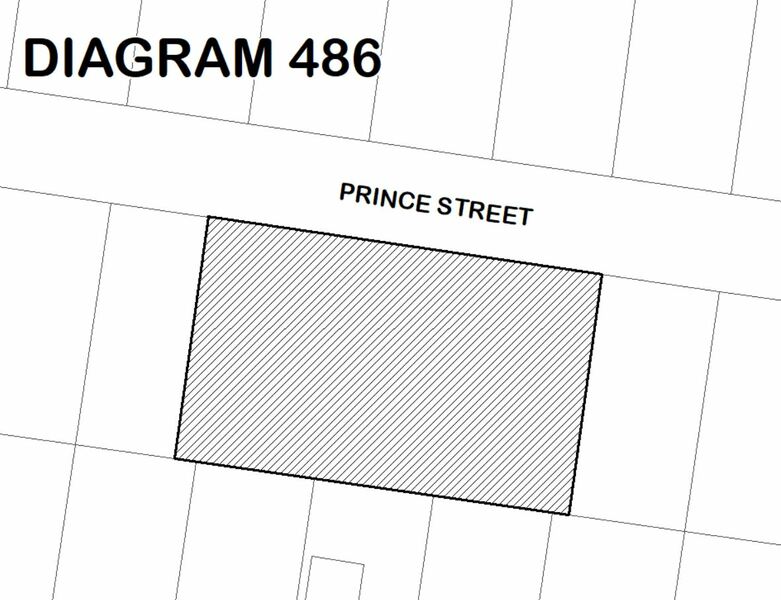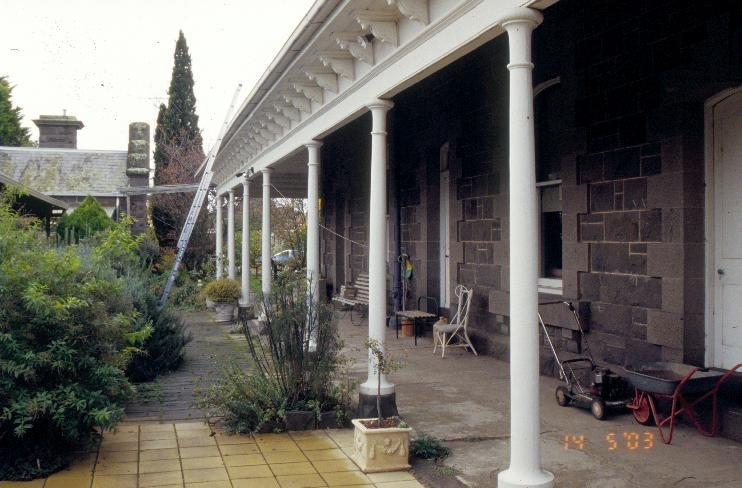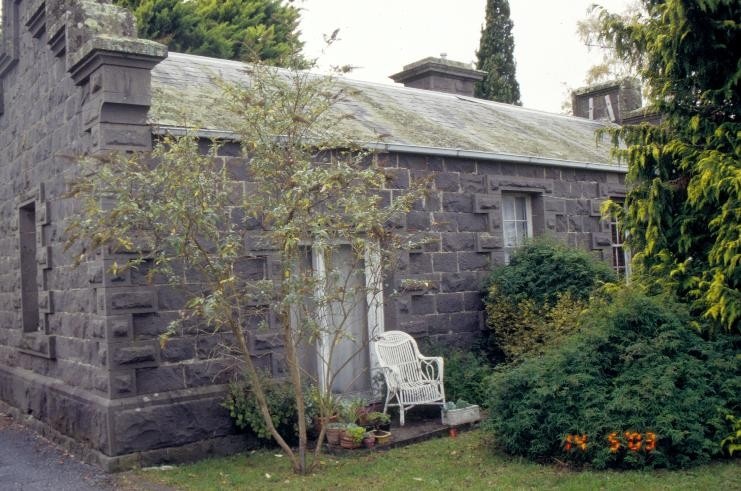Back to search results
LAUDERDALE
7 PRINCE STREET ALFREDTON, BALLARAT CITY
LAUDERDALE
7 PRINCE STREET ALFREDTON, BALLARAT CITY
All information on this page is maintained by Heritage Victoria.
Click below for their website and contact details.
Victorian Heritage Register
-
Add to tour
You must log in to do that.
-
Share
-
Shortlist place
You must log in to do that.
- Download report

Lauderdale - July 2021




On this page:
Statement of Significance
What is significant?
Lauderdale, a single-storey bluestone dwelling constructed c.1864 in the Free Classical style, with a bluestone outbuilding, to designs of an unknown architect.
How is it significant?
Lauderdale is of architectural significance to the State of Victoria. It satisfies the following criterion for inclusion in the Victorian Heritage Register:
Criterion D: Importance in demonstrating the principal characteristics of a class of cultural places and objects.
Why is it significant?
Lauderdale is architecturally significant as an early and elaborate example of a residential complex built in a classically derived style. The residence and its outbuilding are notable as a representative example of such a residential complex of the period. Lauderdale is notable for its use of bracketed eaves to the verandah of the main dwelling, and for the stepped gables and chimney of one outbuilding. Both the residence and its outbuilding are notable for their bluestone construction and detailing. [Criterion D]
Show more
Show less
-
-
LAUDERDALE - Permit Exemptions
General Exemptions:General exemptions apply to all places and objects included in the Victorian Heritage Register (VHR). General exemptions have been designed to allow everyday activities, maintenance and changes to your property, which don’t harm its cultural heritage significance, to proceed without the need to obtain approvals under the Heritage Act 2017.Places of worship: In some circumstances, you can alter a place of worship to accommodate religious practices without a permit, but you must notify the Executive Director of Heritage Victoria before you start the works or activities at least 20 business days before the works or activities are to commence.Subdivision/consolidation: Permit exemptions exist for some subdivisions and consolidations. If the subdivision or consolidation is in accordance with a planning permit granted under Part 4 of the Planning and Environment Act 1987 and the application for the planning permit was referred to the Executive Director of Heritage Victoria as a determining referral authority, a permit is not required.Specific exemptions may also apply to your registered place or object. If applicable, these are listed below. Specific exemptions are tailored to the conservation and management needs of an individual registered place or object and set out works and activities that are exempt from the requirements of a permit. Specific exemptions prevail if they conflict with general exemptions. Find out more about heritage permit exemptions here.Specific Exemptions:Introduction
The purpose of this information is to assist owners and other interested parties when considering or making decisions regarding works to a registered place. It is recommended that any proposed works be discussed with an officer of Heritage Victoria prior to making a permit application. Discussing proposed works will assist in answering questions the owner may have and aid any decisions regarding works to the place.
It is acknowledged that alterations and other works may be required to keep places and objects in good repair and adapt them for use into the future. However, under the Act a person must not knowingly, recklessly or negligently remove, relocate or demolish, damage or despoil, develop or alter or excavate all or any part of any part of a registered place without approval. It should be noted that the definition of ‘develop’ in the Act includes any works on, over or under the place.
If a person wishes to undertake works or activities in relation to a registered place or registered object, they must apply to the Executive Director for a permit. The purpose of a permit is to enable appropriate change to a place and to effectively manage adverse impacts on the cultural heritage significance of a place as a consequence of change. If an owner is uncertain whether a heritage permit is required, it is recommended that Heritage Victoria be contacted.
Permits are required for anything which alters the place or object, unless a permit exemption is granted. Permit exemptions usually cover routine maintenance and upkeep issues faced by owners as well as minor works or works to the elements of the place or object that are not significant. They may include appropriate works that are specified in a conservation management plan. Permit exemptions can be granted at the time of registration (under section 38 of the Act) or after registration (under section 92 of the Act). It should be noted that the addition of new buildings to the registered place, as well as alterations to the interior and exterior of existing buildings requires a permit, unless a specific permit exemption is granted.
Disrepair of registered place or registered object
Under section 152 of the Act, the owner of a registered place or registered object must not allow that place or object to fall into disrepair.
Failure to maintain registered place or registered object
Under section 153 of the Act, the owner of a registered place or registered object must not fail to maintain that place or object to the extent that its conservation is threatened.
Conservation management plans
It is recommended that a Conservation Management Plan is developed to manage the place in a manner which respects its cultural heritage significance.
Archaeology
There is no identified archaeology of State level significance at the place. However, any works that may affect historical archaeological features, deposits or artefacts at the place is likely to require a permit, permit exemption or consent. Advice should be sought from the Archaeology Team at Heritage Victoria.
Aboriginal cultural heritage
To establish whether this place is registered under the Aboriginal Heritage Act 2006 please contact Aboriginal Victoria. The Heritage Act 2017 and the Aboriginal Heritage Act 2006 are separate pieces of legislation. Please be aware that both Acts are required to be satisfied and satisfying the requirements of one Act may not satisfy the requirements of the other.
If any Aboriginal cultural heritage is discovered or exposed at any time it is necessary to immediately contact Aboriginal Victoria to ascertain requirements under the Aboriginal Heritage Act 2006. If works are proposed which have the potential to disturb or have an impact on Aboriginal cultural heritage it is necessary to contact Aboriginal Victoria to ascertain any requirements under the Aboriginal Heritage Act 2006.Other approvals
Please be aware that approval from other authorities (such as local government) may be required to undertake works.
Notes
· All works should ideally be informed by a Conservation Management Plan prepared for the place. The Executive Director is not bound by any Conservation Management Plan, and permits still must be obtained for works suggested in any Conservation Management Plan.· Nothing in this determination prevents the Heritage Council from amending or rescinding all or any of the permit exemptions.· Nothing in this determination exempts owners or their agents from the responsibility to seek relevant planning or building permits where applicable.General Conditions
· All exempted alterations are to be planned and carried out in a manner which prevents damage to the fabric of the registered place.· Should it become apparent during further inspection or the carrying out of works that original or previously hidden or inaccessible details of the place are revealed which relate to the significance of the place, then the exemption covering such works must cease and Heritage Victoria must be notified as soon as possible.
Permit Exemptions
The following permit exemptions are not considered to cause harm to the cultural heritage significance of Lauderdale.
General
· Minor repairs and maintenance which replaces like with like. Repairs and maintenance must maximise protection and retention of significant fabric and include the conservation of existing details or elements. Any repairs and maintenance must not exacerbate the decay of fabric due to chemical incompatibility of new materials, obscure fabric or limit access to such fabric for future maintenance.· Maintenance, repair and replacement of existing external services such as plumbing, electrical cabling, surveillance systems, pipes or fire services which does not involve changes in location or scale.· Repair to, or removal of items such as antennae; aerials; and air conditioners and associated pipe work, ducting and wiring.· Works or activities, including emergency stabilisation, necessary to secure safety in an emergency where a structure or part of a structure has been irreparably damaged or destabilised and poses a safety risk to its users or the public. The Executive Director must be notified within seven days of the commencement of these works or activities.· Painting of previously painted external and internal surfaces in the same colour, finish and product type provided that preparation or painting does not remove all evidence of earlier paint finishes or schemes. This exemption does not apply to areas where there are specialist paint techniques such as graining, marbling, stencilling, hand-painting, murals or signwriting, or to wallpapered surfaces, or to unpainted, oiled or varnished surfaces.· Cleaning including the removal of surface deposits by the use of low-pressure water (to maximum of 300 psi at the surface being cleaned) and neutral detergents and mild brushing and scrubbing with plastic (not wire) brushes.Interiors (Lauderdale residence and c.1860s outbuilding)
· Works to maintain or upgrade existing bathrooms, kitchens and laundries, including installing new appliances, re-tiling and the like.· Installation, removal or replacement of carpets and/or flexible floor coverings, window furnishings, and devices for mounting wall hung artworks.· Installation, removal or replacement of existing electrical wiring. If wiring is currently exposed, it should remain exposed. If it is fully concealed it should remain concealed.· Removal or replacement of smoke and fire detectors, alarms and the like, of the same size and in existing locations.· Repair, removal or replacement of existing ducted, hydronic or concealed radiant type heating provided that the central plant is concealed, and that the work is done in a manner which does not alter building fabric.· Installation of plant within the roof space, providing that it does not impact on the external appearance of the building or involve structural changes.· Installation, removal or replacement of bulk insulation in the roof space.Landscape/ outdoor areas
Hard landscaping and services
· Subsurface works to existing watering and drainage systems.· Repair and maintenance of existing hard landscaping including paving and driveways.· Installation of physical barriers or traps to enable vegetation protection and management of vermin such as rats, mice and possums.Gardening, trees and plants
· The processes of gardening including mowing, pruning, mulching, fertilising, removal of dead or diseased plants, replanting of existing garden beds, disease and weed control and maintenance to care for existing plants.· Removal of tree seedlings and suckers without the use of herbicides.· Emergency tree works to maintain public safety provided the Executive Director is notified within seven days of the removal or works occurring.Modern car port to the west of the Lauderdale residence· All maintenance and repair works.· Demolition.
-
-
-
-
-
BALLARAT HIGH SCHOOL
 Victorian Heritage Register H1797
Victorian Heritage Register H1797 -
Beaufort House
 National Trust
National Trust -
Lauderdale Homestead
 National Trust H0486
National Trust H0486
-
"1890"
 Yarra City
Yarra City -
"AMF Officers" Shed
 Moorabool Shire
Moorabool Shire -
"AQUA PROFONDA" SIGN, FITZROY POOL
 Victorian Heritage Register H1687
Victorian Heritage Register H1687
-
'Altona' Homestead (Formerly 'Laverton' Homestead) and Logan Reserve
 Hobsons Bay City
Hobsons Bay City
-
-















